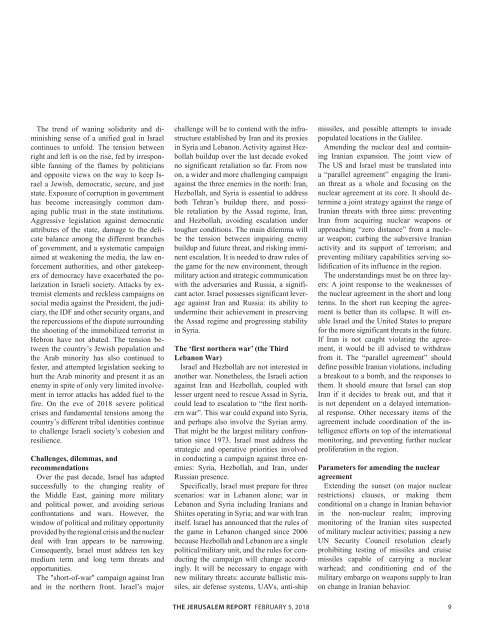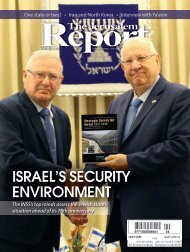All small
You also want an ePaper? Increase the reach of your titles
YUMPU automatically turns print PDFs into web optimized ePapers that Google loves.
The trend of waning solidarity and diminishing<br />
sense of a unified goal in Israel<br />
continues to unfold. The tension between<br />
right and left is on the rise, fed by irresponsible<br />
fanning of the flames by politicians<br />
and opposite views on the way to keep Israel<br />
a Jewish, democratic, secure, and just<br />
state. Exposure of corruption in government<br />
has become increasingly common damaging<br />
public trust in the state institutions.<br />
Aggressive legislation against democratic<br />
attributes of the state, damage to the delicate<br />
balance among the different branches<br />
of government, and a systematic campaign<br />
aimed at weakening the media, the law enforcement<br />
authorities, and other gatekeepers<br />
of democracy have exacerbated the polarization<br />
in Israeli society. Attacks by extremist<br />
elements and reckless campaigns on<br />
social media against the President, the judiciary,<br />
the IDF and other security organs, and<br />
the repercussions of the dispute surrounding<br />
the shooting of the immobilized terrorist in<br />
Hebron have not abated. The tension between<br />
the country’s Jewish population and<br />
the Arab minority has also continued to<br />
fester, and attempted legislation seeking to<br />
hurt the Arab minority and present it as an<br />
enemy in spite of only very limited involvement<br />
in terror attacks has added fuel to the<br />
fire. On the eve of 2018 severe political<br />
crises and fundamental tensions among the<br />
country’s different tribal identities continue<br />
to challenge Israeli society’s cohesion and<br />
resilience.<br />
Challenges, dilemmas, and<br />
recommendations<br />
Over the past decade, Israel has adapted<br />
successfully to the changing reality of<br />
the Middle East, gaining more military<br />
and political power, and avoiding serious<br />
confrontations and wars. However, the<br />
window of political and military opportunity<br />
provided by the regional crisis and the nuclear<br />
deal with Iran appears to be narrowing.<br />
Consequently, Israel must address ten key<br />
medium term and long term threats and<br />
opportunities.<br />
The "short-of-war" campaign against Iran<br />
and in the northern front. Israel’s major<br />
challenge will be to contend with the infrastructure<br />
established by Iran and its proxies<br />
in Syria and Lebanon. Activity against Hezbollah<br />
buildup over the last decade evoked<br />
no significant retaliation so far. From now<br />
on, a wider and more challenging campaign<br />
against the three enemies in the north: Iran,<br />
Hezbollah, and Syria is essential to address<br />
both Tehran’s buildup there, and possible<br />
retaliation by the Assad regime, Iran,<br />
and Hezbollah, avoiding escalation under<br />
tougher conditions. The main dilemma will<br />
be the tension between impairing enemy<br />
buildup and future threat, and risking imminent<br />
escalation. It is needed to draw rules of<br />
the game for the new environment, through<br />
military action and strategic communication<br />
with the adversaries and Russia, a significant<br />
actor. Israel possesses significant leverage<br />
against Iran and Russia: its ability to<br />
undermine their achievement in preserving<br />
the Assad regime and progressing stability<br />
in Syria.<br />
The ‘first northern war’ (the Third<br />
Lebanon War)<br />
Israel and Hezbollah are not interested in<br />
another war. Nonetheless, the Israeli action<br />
against Iran and Hezbollah, coupled with<br />
lesser urgent need to rescue Assad in Syria,<br />
could lead to escalation to “the first northern<br />
war”. This war could expand into Syria,<br />
and perhaps also involve the Syrian army.<br />
That might be the largest military confrontation<br />
since 1973. Israel must address the<br />
strategic and operative priorities involved<br />
in conducting a campaign against three enemies:<br />
Syria, Hezbollah, and Iran, under<br />
Russian presence.<br />
Specifically, Israel must prepare for three<br />
scenarios: war in Lebanon alone; war in<br />
Lebanon and Syria including Iranians and<br />
Shiites operating in Syria; and war with Iran<br />
itself. Israel has announced that the rules of<br />
the game in Lebanon changed since 2006<br />
because Hezbollah and Lebanon are a single<br />
political/military unit, and the rules for conducting<br />
the campaign will change accordingly.<br />
It will be necessary to engage with<br />
new military threats: accurate ballistic missiles,<br />
air defense systems, UAVs, anti-ship<br />
missiles, and possible attempts to invade<br />
populated locations in the Galilee.<br />
Amending the nuclear deal and containing<br />
Iranian expansion. The joint view of<br />
The US and Israel must be translated into<br />
a “parallel agreement” engaging the Iranian<br />
threat as a whole and focusing on the<br />
nuclear agreement at its core. It should determine<br />
a joint strategy against the range of<br />
Iranian threats with three aims: preventing<br />
Iran from acquiring nuclear weapons or<br />
approaching “zero distance” from a nuclear<br />
weapon; curbing the subversive Iranian<br />
activity and its support of terrorism; and<br />
preventing military capabilities serving solidification<br />
of its influence in the region.<br />
The understandings must be on three layers:<br />
A joint response to the weaknesses of<br />
the nuclear agreement in the short and long<br />
terms. In the short run keeping the agreement<br />
is better than its collapse. It will enable<br />
Israel and the United States to prepare<br />
for the more significant threats in the future.<br />
If Iran is not caught violating the agreement,<br />
it would be ill advised to withdraw<br />
from it. The “parallel agreement” should<br />
define possible Iranian violations, including<br />
a breakout to a bomb, and the responses to<br />
them. It should ensure that Israel can stop<br />
Iran if it decides to break out, and that it<br />
is not dependent on a delayed international<br />
response. Other necessary items of the<br />
agreement include coordination of the intelligence<br />
efforts on top of the international<br />
monitoring, and preventing further nuclear<br />
proliferation in the region.<br />
Parameters for amending the nuclear<br />
agreement<br />
Extending the sunset (on major nuclear<br />
restrictions) clauses, or making them<br />
conditional on a change in Iranian behavior<br />
in the non-nuclear realm; improving<br />
monitoring of the Iranian sites suspected<br />
of military nuclear activities; passing a new<br />
UN Security Council resolution clearly<br />
prohibiting testing of missiles and cruise<br />
missiles capable of carrying a nuclear<br />
warhead; and conditioning end of the<br />
military embargo on weapons supply to Iran<br />
on change in Iranian behavior.<br />
THE JERUSALEM REPORT FEBRUARY 5, 2018 9
















